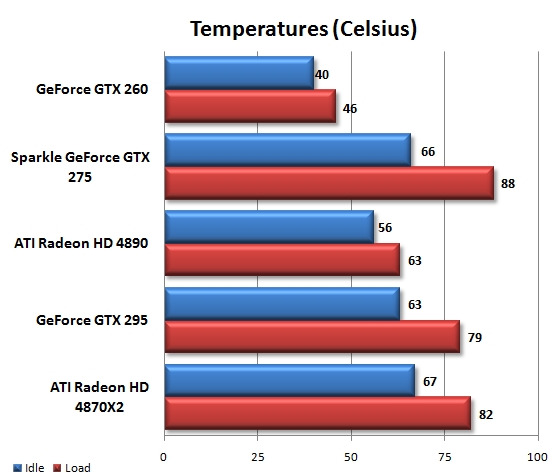Sparkle GeForce GTX 275 Video Card Review
Power Consumption, Temperatures
I tested total system power consumption at idle, while gaming, and in 3DMark 2006. The latter deserves a bit of explanation, since my “Peak” value is derived from it. Put simply, there are Feature Tests in 3DMark 2006 that unintentionally create a worst-case thermal scenario.

The test used to create the “Peak” values actually varies between ATI and NVIDIA. For ATI, it’s 3DM2K6’s Perlin Noise benchmark that draws so much power, while cards from Team Green hit their peak values in the first pixel shader benchmark. I’ve previously spoken to NVIDIA about these results and the company confirmed them, but wasn’t able to provide an explanation as to why they occur.
Average results were recorded using a Kill-A-Watt meter while looping our Crysis Warhead benchmark at 1900×1200, 8xAA, 16xAF, with all detail levels set to maximum. I tested other games in our suite, including H.A.W.X. and Clear Sky, in order to confirm that Crysis Warhead represented a fair scenario of “real world” system power consumption.
If you’re unsure which power consumption value to pay attention to, it breaks down like this: if you tend to leave your computer on for hours at a time without any form of advanced sleep state enabled, your system is drawing at Idle. If you’re curious about your current power consumption while gaming, the average value is what you want. Finally, if you’re planning on buying a new power supply (or trying to calculate if you can safely use a current one), I’d pay attention to the peak value. Although these values were gathered using specific feature tests, they may be replicated by current or future games in an appropriate detail configuration. Peak values represent the highest power consumption figures I’ve ever been able to create, but are not guaranteed as the absolute top value for any particular card.
Thermals

GPU temperatures were gathered using GPU-Z while looping the appropriate 3DM2K6 test as listed above. Keep in mind that the system itself was not enclosed in a chassis and actually sits under an air conditioning vent. In addition, I tend to keep the air conditioning on full-blast.
In this case, the Sparkle card ends up the surprise “winner,” but in all fairness, I can’t say the card’s higher temperatures ever caused an issue, lockup, or unexpected shutdown. A GTX 275 might not be the smartest choice to stuff inside an SFF with two hard drives, a quad-core, and an undersized exhaust fan, but there’s no reason to think the card can’t handle its operating temperature.

Comments are closed.